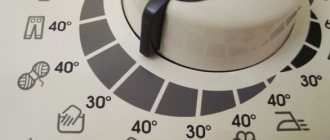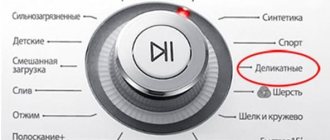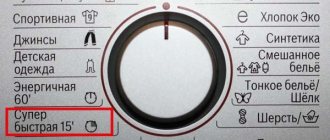Modern automatic washing machines have extensive built-in functionality.
The devices are already equipped with the most popular programs, which are very convenient to use. Among the popular modes is “quick wash” in various variations.
This is exactly what a modern dynamic person needs. We'll talk more about the Quick wash mode in a washing machine in the article.
What kind of regime is this, how long does it last?
The “quick wash” mode is available in almost every model of washing machine, regardless of the manufacturer. This program may be called differently in different models. But its essence remains the same - complete processing of laundry in a very limited time.
The entire full cycle, including the washing itself, rinsing and spinning, takes an average of 15-30 minutes . Often a very short cycle of a quarter of an hour is called “super-fast wash” by manufacturers of automatic washing machines or simply designated “15 minutes.”
Some models have a quick wash for 30 minutes, and a super-fast wash for a quarter of an hour. In this case, short modes can be marked with a stylized clock highlighting the processing time.
The mode is aimed at processing lightly soiled laundry. Express treatment makes it possible to eliminate the smell of sweat and refresh items that are not very worn and do not have obvious stains. For example, they were worn only for a few hours.
In addition to quick processing, there are modes that wash under similar conditions, but for a longer time. For example, “synthetics”. Linen made from artificial materials is washed at a low temperature, but takes longer and is rinsed more thoroughly.
What to do to make the material shrink
Cotton often stretches when worn. A striking example of this is jeans, whose material is denim, which is made from cotton. Washing will help return it to its original size.
In the washing machine
Items made from medium weight fabric are washed at 60°C, thick cotton – at 90°C. To make it sit down, set the maximum number of revolutions. It can be either 900 rpm or 1200. The built-in dryer won’t hurt either. Hot air will greatly promote shrinkage.
Manually
Shrinkage may also occur when hand washed. To do this, after rinsing, add boiling water and conditioner to the container. Cover the container with a lid or bag and leave for 5-7 minutes. Then the items are thoroughly rinsed in cold water and wrung out.
How does this function work, at how many degrees?
The fast processing mode includes all the stages of a full wash, but with some restrictions on the duration of the stages and the intensity of processing.
If things are not very dirty, then high-quality washing can be carried out at a low water heating temperature - when the temperature indicator is set to 30 or 40ºС.
After washing, the washing machine proceeds to normal rinsing. Next - to the spin cycle. Thus, all generally accepted processing steps have been followed. Reducing processing time is achieved due to low heating of water, reducing the rinse and spin cycle.
The fast processing mode on most models cannot be supplemented with additional rinsing, ironing and other functions that lengthen the processing process.
Drying
Cotton products are dried in a molten state. This greatly facilitates the subsequent ironing process. It is better to dry thin clothes on hangers.
It is not recommended to leave items in direct sunlight, which may cause the items to fade or turn yellow. Cotton items dry quite quickly. They can be removed in a slightly damp state, which makes the ironing process as convenient as possible.
Washing cotton items correctly is not that difficult. The main thing is to know the basic rules, then the product will not only become dazzlingly clean again, but will also retain all its characteristics.
Installation features, possible startup problems
Selecting a quick wash mode is an easy task. For many models, this program is displayed separately, so it is easy to set.
If the wash does not start after pressing start, you should pay attention to the display of the machine or to the indicators if the machine does not have a display. It often happens that through self-diagnosis, the washing machine itself will tell you what the problem is. The system of fault codes is described in the instructions for each device.
Frequent failures include overload, underload, and door not closing tightly. Based on the error code, in most cases you can even correct the situation yourself and get things working properly.
If the washing machine does not turn on, you can restart it . This is done as follows: the device is disconnected from the network (the plug is pulled out of the socket), and after a quarter of an hour it is plugged back into the network. This method will help if the failure was a one-time one.
If you cannot fix the problem on your own, you must contact a company that repairs washing machines.
Variety of cotton
Cotton fabric is one of the most popular materials in the textile industry. This was facilitated by the practical, hygienic and aesthetic properties of the fabric, as well as its low cost. Cotton is the basis of such materials as denim, chintz, satin, and calico. It is used for both clothing and home textiles.
Thanks to a large selection of weavings, the industry has learned to produce cotton materials of different densities and structures. Since they are based on cotton fibers, in most cases the conditions for washing and drying them are the same.
How to install?
The procedure when you just need to refresh your laundry includes the following steps:
Place laundry in an empty drum.- Pour the detergent into the powder receptacle cuvette (the quantity is less than the usual norm).
- Turn on the washing machine.
- Select the “quick wash” icon from the list of modes.
- Launch the program by clicking the “start” button.
- After 15-30 minutes (depending on the model of the washing machine), you can remove the washed laundry from the drum.
In the case where things are dirty, you can combine a quick wash with pre-treatment by hand.
The order of work in this case is supplemented by the following initial stages:
- Soak things in warm water for a quarter of an hour.
- Rub the contaminated areas with soap (laundry soap or with a stain-removing effect).
- Squeeze out excess water from laundry.
- Place items in the washing machine drum.
- Pour in the powder.
- Start quick wash mode
Some models of washing machines may not have a separate mode called “quick wash”. In this case, it is necessary to study all the functionality of the washing machine.
The desired mode may be called “Accelerated” or, for example, “Express mode”. You can use any program whose duration is within 30-40 minutes.
The type of loading (vertical or horizontal) does not affect the presence or absence of a fast mode.
Preliminary
The cotton pre-wash mode involves processing items before the main wash. It should be activated in the following cases:
- things are very dirty;
- there are stubborn stains on the products;
- Clothes emit persistent unpleasant odors.
Prewash is compatible with the Cotton programme. Features of the mode:
The water temperature at the pre-wash stage is 30 degrees. If higher heating has been set, the heating element is activated at the main stage.- The maximum time is 2 hours, but most often this stage lasts about 50 minutes.
- Washing powder should be poured into section number 1.
- Liquid detergents are not used for pre-washing, as they will simply flow into the drum in the first minutes of starting the program.
Activating the prewash always increases the operating time of the machine. That is, about an hour will be spent on the initial processing of things, after which the main program will start working. This results in greater consumption of detergents, water and electricity.
Pre-washing is not recommended for cleaning items that are subject to heavy shedding.
Read more here.
Advantages and disadvantages of application
Quick wash is one of the fairly popular user modes. Its demand is associated with a large number of advantages. Among the advantages of the mode:
- saving water;
- saving electricity;
- less wear and tear on the fabric, since washing does not differ in intensity;
- saving time;
- saving detergent;
- relatively small load on the parts and components of the device.
There are also some drawbacks . In some cases, they can be critical and will not allow you to use the program in all cases without exception:
Often it is not possible to supplement the program with options that are set manually (increase the heating temperature, introduce an additional rinse, etc.);- heavily soiled items may not be washed well;
- if you exceed the powder norm, then unrinsed particles of detergent or stains may remain on things;
- After washing, a strong, distinct smell of detergent may remain on the items.
Constant washing only at low temperatures when operating the washing machine is not advisable, as this contributes to the formation of deposits on working parts in contact with water.
In addition, when processed at a low temperature, mold may develop in the tank, fungus and an unpleasant musty smell may appear.
Water temperature
Washing on the “Cotton” program involves processing laundry at high temperatures. Its maximum value is 90 degrees. However, such heating is only permissible for caring for white, durable fabrics made from natural cotton. Other materials may be damaged during prolonged heating. The main danger is deformation of products and their shedding.
Manufacturers of all washing machines provide users with the ability to change the heating temperature. It can be reduced to 60, 40 or 30 degrees . This is especially true if the fabric contains other fibers in addition to cotton, or the items are not too dirty.
When should you not wash quickly?
Accelerated washing mode is an option that is not always acceptable. This mode is not suitable for a number of things. Among the prohibitions are the following:
- Children's underwear - it requires more careful processing at high temperatures.
- Wool and silk - for them you need to use only special modes and a special detergent.
- Very dirty items simply cannot be washed off in a quick wash.
- Worn things - they are not processed intensively.
- Delicate items - during rapid processing they can become deformed and become unusable, since the processing process is very vigorous.
- Bed linen, towels - it is advisable to process them on longer and more intensive modes in order to disinfect and wash better.
- Bulk items (pillows, down jackets, etc.) – detergents will remain on them.
- Shoes - there is a special mode for them without spinning, otherwise you can damage the components of the washing machine.
When using the quick wash mode, the drum of the washing machine should not be filled completely, as this will prevent things from being washed and will make rinsing difficult.
Optimally, fill the drum only halfway . This will allow the detergent to dissolve better in water, distribute better and better rinse things after the washing stage.
If there are a lot of things to wash, they need to be sorted and divided into separate batches, which in volume and weight will not exceed half the drum load.
What does a full cycle consist of?
The sequential execution of the usual stages - washing, rinsing and wringing out things - constitutes a full cycle of operation of the machine. The device allows you to regulate the specifics of these operations.
Wash
The choice of washing mode is determined by the following parameters:
- fabric structure;
- the presence of decorative elements on products;
- contamination (you can include soaking, boiling cotton fabrics).
The right choice will determine not only how well things are washed, but also possible damage to the laundry from the aggressive effects of temperature and high speeds.
Rinsing
When rinsing, detergents are washed out of fabrics. Many people prefer to run an additional rinse mode to thoroughly wash the laundry from powder.
Spin
Choosing the right spin is the key to easy and enjoyable ironing. Only cotton fabrics should be spun at high speeds. Linen, silk, and synthetics should not be wrung out too much so as not to damage the fabric and make ironing easier.
Summing up
Programs in modern washing devices save time and reduce bills for electricity and water, make it possible to wash complex stains and eliminate allergens. Do not neglect the use of different modes and turn on only one of the many programs.
When purchasing, you should not chase the number of functions in the device. It is necessary to think in advance which functions will be used and which will not be useful at all, and give preference to the model that will meet the requirements. The number and set of modes is not the only indicator that you should look at when choosing a device. Don’t forget to evaluate the dimensions of the device, its power, energy efficiency class, and drum volume.











